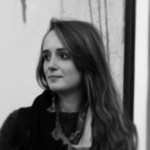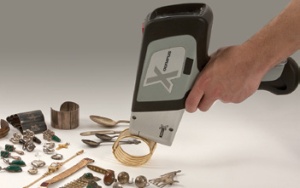: HERMA
NARNIA: the Magical Land of Archaeological Science
NARNIA, or the mouthful New Archaeological Research Network for Integrating Approaches to ancient material studies, is a research project funded by the EU through the Marie Curie Initial Training Networks. The project’s lengthy title, abbreviated into a snappy acronym reminiscent of fantastic tales and adventures defines its purpose well: to build an interdisciplinary network between participating organizations and to facilitate work of young researches in cutting-edge disciplines of archaeological science. Network, coordinate, collaborate, integrate – a modern approach to doing archaeology.

Peter Grave using PXRF to reveal the elemental signature of a basalt axe head.
Photographer: Cate Lowe
Rights: © Australian Museum
However, NARNIA also has outreach training courses and workshops intended for interested parties not directly involved in the project. These range from technical training courses on specific methodologies (eg. applications of PXRF) to broader theories and practices of documentation and conservation of ancient materials.
Why would you care if you are not the one pointing lasers and peeking through microscopes? For one, trying to extract as much interpretable data from materials and objects as possible using multiple macro- and microscopic methods is a longstanding trend in archaeology. Everything matters; such multidisciplinary approaches drive a lot of modern research and excavation, especially lately as competition is increasing and funding is scarce. Archaeologists study the past but are nowadays very oriented towards the future – enthusiastic about potential new horizons afforded to them by new technologies – and even if they aren’t, they still might end up collaborating with a colleague who very much is. For this reason training workshops such as NARNIA’s are not only useful to young researchers working towards a particular specialization, they are of potential value to other (fieldwork) archaeologists, conservators and heritage workers who wish to update their knowledge on the latest developments in archaeological science as well as to connect with specialists with whom they (didn’t even know they) might want to collaborate. For them, it is important to maintain scientific rigor through having a thorough understanding of how to choose methods that are suitable for the questions being asked, what they can and cannot do along with how to interpret results appropriately.
The workshops are also valuable to students for networking purposes as well as to get a better grasp of what archaeological science actually entails, especially if they are interested in pursuing further studies and a prospective career in these disciplines. Students study archaeology mostly through readings, lectures and practical work in controlled conditions, where they disproportionately deal more with the end-results of others’ (sometimes lifetime) accomplishments and spend less time talking about the drudge-work of field and lab archaeology, i.e. the day-to-day life of an archaeologist. By participating in excavations or lab work, students experience the process of archaeology, rather than just having a glamorized and sometimes (or most times?) misleading mental image of being an archaeologist and can therefore better conclude if such a lifestyle appeals to them and which aspects of archaeology they truly wish to pursue. However, if latest developments in methodologies interest them and their school or organization doesn’t have resident experts and facilities, eg. a radiocarbon dating lab, workshops like NARNIA’s can be a great opportunity to experience and to be inspired by the vibrant future of high-tech archaeology. Interested? Off to NARNIA then!
Sandra Šoštarić graduated in Prehistoric Archaeology, with a focus in bioarchaeology of human bones. Her main interests involve health and disease of past human populations as well as the use of new technology and digital solutions in archaeological research. Having had a breadth of practical experience in different facets of archaeology and related disciplines, from digital documenting of excavations to forensic anthropology, she realizes she loves the past almost as much as the future.
Museum of Greek Folk Art (Athens)
In the pretty and touristy neighbourhood of Plaka lies quite a different and interesting museum, although (surprisingly) the few number of visitors seem to testify that it is not very well-known. This allows one to walk around the various rooms in a very quiet and peaceful environment, but at the same time, I could not help but feel sad and worried about this situation. I will be sharing my experience in the Museum of Greek Folk Art in the hope that my words might awaken the curiosity of anyone visiting Athens, leading to (I promise!) a very enriching and also fun experience.
The museum was established in 1918 and transferred from the Tzisdarakis Mosque in Monastiraki Square into 17 Kydathinaion Street in Plaka in 1973. Apart from the fact that none of the rooms are illuminated by natural light and that the exhibitions have not been reorganized in a more visitor-friendly way in many decades, this museum holds a fascinating and extremely diverse collection. Going up until I reached the fourth and final floor, I felt like I was traveling in time and space, throughout many distant regions of 18th to 20th century Greece. This made me come to the happy realization that the country´s culture and traditions are far richer and more diverse than I had imagined. Another interesting aspect of this museum is that objects from other close parts of the world (such as Italy and Turkey) are also exhibited, as to show some of the foreign influences that helped form the cultural identity of Modern Greeks during these centuries.
As soon as you enter (free of charge for European Union students) you will soon be aware of what the ground floor is dedicated to – embroidery, some of which are quite intimidating in size. I was surprised to see a medieval looking piece whose colour and human representations reminded me of the Bayeux Tapestry; although this tendentious view might be related to my slight obsession with everything medieval. Throughout the three other floors one can explore regional costumes, masquerades, silver and gold work, pottery, shadow theatre, folk painting (works of the naïve painter Theophilos Hatzimichail) and much, much more.
Personally, what fascinated me the most was the exhibition about shadow theatre. This type of performing art originated in the East and was later brought to Greece, where it was quickly assimilated. This might be due to the fact that through these peculiar looking puppets, stories related to social issues – such as oppression and uprisings, poverty and heroism – used to be told. Popular and entertaining ways of expressing social feelings and anxieties have always been common in various cultures, and it is interesting to relate their popularity to specific historic periods.
The metal work exhibition was very impressive and some of the pieces were so big that I felt sorry for the person who had to wear them – although quite jealous too, I must confess, for they were made with beautiful and intricate detail. Some of the masquerades were very scary and slightly reminded me of traditional costumes from Trás-os-Montes, a Northern region of Portugal – it is quite remarkable how distant cultures can be so different, yet still hold some similarities.
I will not go into further details about all the other collections, for that would occupy far too much space and time when it is really worthwhile to see for oneself. I will end this little article by saying that I wish every tourist (and also Greeks) would include this museum on their list of destinations and wanders around Athens. There is much, much more to Greece than the white marbled Ancient ruins and the beautiful islands. This specific museum proves my words in a most fascinating way.
 Sofia Lovegrove is currently working as an intern at the Initiative for Heritage Conservancy. She is interested in archaeological research and Public Archaeology. When not working for IHC, Sofia is also a volunteer at the Athenian Agora.
Sofia Lovegrove is currently working as an intern at the Initiative for Heritage Conservancy. She is interested in archaeological research and Public Archaeology. When not working for IHC, Sofia is also a volunteer at the Athenian Agora.


